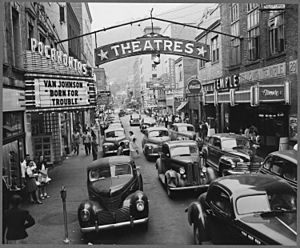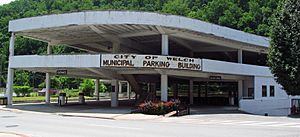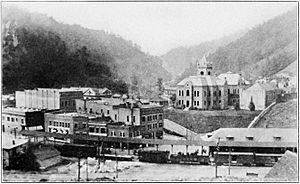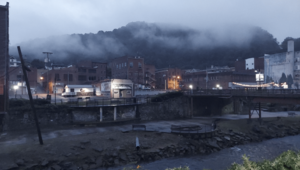Welch, West Virginia facts for kids
Quick facts for kids
Welch, West Virginia
|
|||
|---|---|---|---|
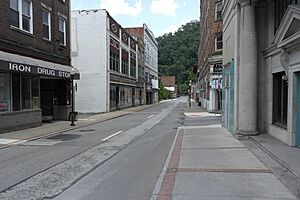
Facing south on McDowell Street in 2019
|
|||
|
|||
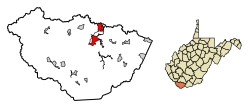
Location of Welch in McDowell County, West Virginia
|
|||
| Country | United States | ||
| State | West Virginia | ||
| County | McDowell | ||
| Area | |||
| • Total | 6.07 sq mi (15.71 km2) | ||
| • Land | 6.04 sq mi (15.64 km2) | ||
| • Water | 0.03 sq mi (0.08 km2) | ||
| Elevation | 1,322 ft (403 m) | ||
| Population
(2020)
|
|||
| • Total | 3,590 | ||
| • Estimate
(2023)
|
3,414 | ||
| • Density | 594/sq mi (229.5/km2) | ||
| Time zone | UTC−5 (EST) | ||
| • Summer (DST) | UTC−4 (EDT) | ||
| ZIP Code |
24801
|
||
| Area code(s) | 304 | ||
| FIPS code | 54-85228 | ||
| GNIS feature ID | 1555936 | ||
Welch is a city in West Virginia, United States. It is the main city and county seat of McDowell County. In 2020, about 3,590 people lived there. Welch became an official city in 1893. It is located where the Tug Fork and Elkhorn Creek meet.
Contents
History of Welch, West Virginia
Welch was officially made a city in 1893. It was named after Isaiah A. Welch, who was a surveyor. He helped plan the new town where the Tug Fork and Elkhorn Creek come together.
Becoming the County Seat
Before Welch was even a city, citizens of McDowell County voted in 1892 to make it the county seat. This means it became the main town for the county government. The old county seat was in Perryville, which is now called English.
The election results were argued over. To avoid any trouble, county records were secretly moved from Perryville to Welch one night. Two men, James F. Strother and Trigg Tabor, moved the records in two wagons.
Early 20th Century Growth
In the early 1900s, Welch became a busy and successful city. This was because railroads and coal mines were opening all over the region. Welch became the main shopping area for McDowell County, which had nearly 100,000 people. The city also had three hospitals.
After World War II, things started to change. Oil began to replace coal as a fuel source. Also, new machines meant fewer workers were needed in coal mines. Because of this, McDowell County's population started to go down after 1950.
However, in 1960, McDowell County was still the top coal producer in the United States. Welch proudly called itself "The Heart of the Nation's Coal Bin."
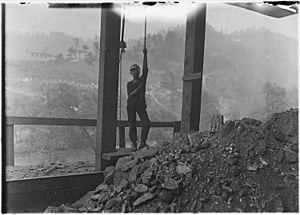
President Kennedy's Visit and Food Stamps
In 1960, John F. Kennedy visited Welch when he was running for president. He saw that many businesses were struggling because of growing poverty in the county. What Kennedy learned here helped him create aid programs for the Appalachian region later on.
On September 27, 1960, Kennedy gave a speech in Canton, Ohio. He said that McDowell County mined more coal than ever, but also had more people receiving food aid than any other county. He explained this was because machines were doing jobs that men used to do, and new jobs were needed.
On May 29, 1961, Welch was part of a big moment in history. The first modern food stamps were given out here. A family of fifteen, the Chloe and Alderson Muncy family, received $95 in food stamps. This event started a large program of federal help known as the "War on Poverty."
Later Challenges and Changes
In the 1960s and 1970s, coal from McDowell County was still very important for making steel and electricity. But as steel production in the U.S. went down, McDowell County faced more problems. In 1986, a large coal mine closed nearby, causing over 1,200 people to lose their jobs.
This led to a big drop in personal income and property values. Many miners had to leave their homes to find work elsewhere.
Historic Places in Welch
The McDowell County Courthouse and the Welch Commercial Historic District are special places. They are listed on the National Register of Historic Places because of their historical importance.
Welch's Unique Firsts
Welch is known for a couple of "firsts" in West Virginia and the United States.
First Public Children's Playground
In 1913, Welch built the first public children's playground in West Virginia. People donated money to build it. Later, a church group helped take care of it. The playground was located across from the McDowell County Courthouse. In 1930, a new Post Office was built on that spot.
First Municipal Parking Building
Welch also built the first parking garage owned by a city in the United States. It opened on September 1, 1941. This building could hold 232 cars and even made money in its first year!
Geography and Location
Welch is located in a beautiful area of West Virginia. The city covers about 6.04 square miles of land and a small amount of water.
Rivers and Flooding
The city is near the Elkhorn and Tug Fork rivers. Sometimes, these rivers flood, which has caused problems for the city. Big floods in 2001 and 2002 caused a lot of damage. Now, projects are underway to help prevent future floods.
Transportation Routes
Welch has important roads that pass through it:
The town also has a railway station on the Norfolk Southern Railway line.
Population and Demographics
The population of Welch has changed over the years.
| Historical population | |||
|---|---|---|---|
| Census | Pop. | %± | |
| 1900 | 442 | — | |
| 1910 | 1,525 | 245.0% | |
| 1920 | 3,232 | 111.9% | |
| 1930 | 5,376 | 66.3% | |
| 1940 | 6,264 | 16.5% | |
| 1950 | 6,603 | 5.4% | |
| 1960 | 5,313 | −19.5% | |
| 1970 | 4,149 | −21.9% | |
| 1980 | 3,885 | −6.4% | |
| 1990 | 3,028 | −22.1% | |
| 2000 | 2,683 | −11.4% | |
| 2010 | 2,406 | −10.3% | |
| 2020 | 3,590 | 49.2% | |
| 2023 (est.) | 3,414 | 41.9% | |
| U.S. Decennial Census 2020 Census |
|||
2020 Census Information
According to the 2020 United States census, there were 3,590 people living in Welch. There were 844 households and 517 families.
| Ethnicity | Num. | Perc. |
|---|---|---|
| White | 2,139 | 59.58% |
| Black or African American | 1,010 | 28.13% |
| Hispanic or Latino | 325 | 9.05% |
| Asian | 9 | 0.25% |
| Native American | 8 | 0.22% |
| Pacific Islander | 1 | 0.01% |
| Other or mixed | 99 | 2.76% |
2010 Census Information
In the census of 2010, there were 2,406 people, 984 households, and 554 families in the city. The population density was about 400 people per square mile.
The average age in Welch was 44 years old. About 15.5% of residents were under 18. About 17.8% were 65 or older.
Education in Welch
Welch High School was a three-story building in Welch. It was designed in 1906. A gymnasium was added in 1938. The school was built with brown brick on a hillside.
The school's mascot was the Maroon Wave. The football team won a championship in 1928. The school became integrated in 1957, meaning students of all races could attend. In 1963, the football team had an undefeated season.
Notable People from Welch
Many interesting people have connections to Welch, West Virginia:
- Jeannette Walls
- Steve Harvey – A famous television host, producer, actor, and comedian (born 1957).
- Frank Sampedro – A musician (born 1949).
Images for kids
-
Child laborer at Welch Mining Company, 1908. Photo by Lewis Hine
See also
 In Spanish: Welch (Virginia Occidental) para niños
In Spanish: Welch (Virginia Occidental) para niños




